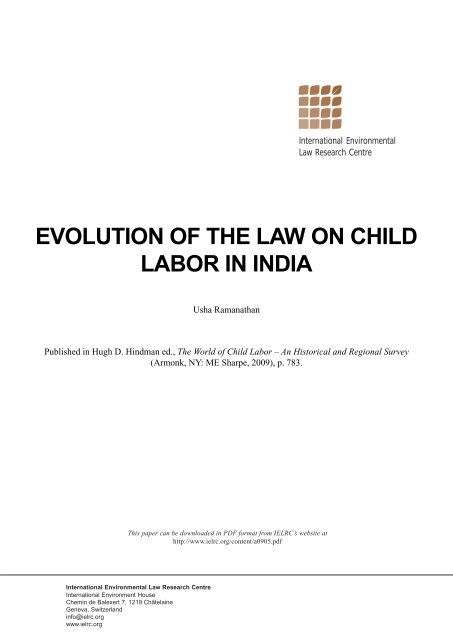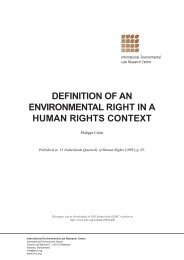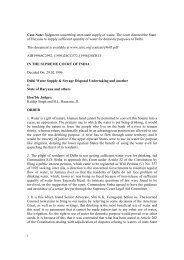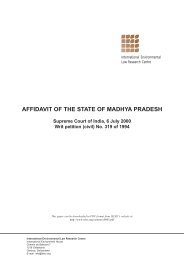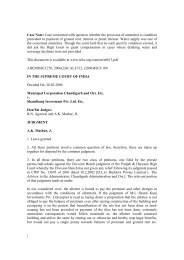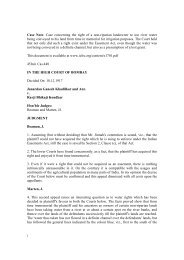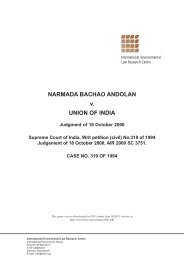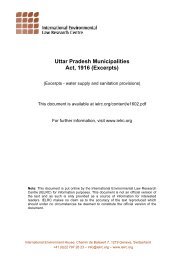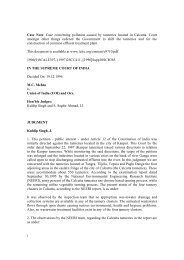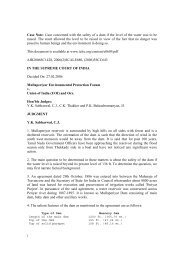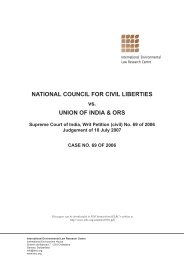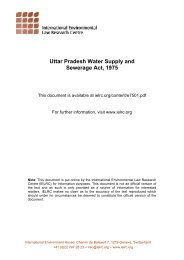Evolution of the Law on Child Labor in India - International ...
Evolution of the Law on Child Labor in India - International ...
Evolution of the Law on Child Labor in India - International ...
Create successful ePaper yourself
Turn your PDF publications into a flip-book with our unique Google optimized e-Paper software.
Internati<strong>on</strong>al Envir<strong>on</strong>mental<str<strong>on</strong>g>Law</str<strong>on</strong>g> Research CentreEVOLUTION OF THE LAW ON CHILDLABOR IN INDIAUsha RamanathanPublished <strong>in</strong> Hugh D. H<strong>in</strong>dman ed., The World <str<strong>on</strong>g>of</str<strong>on</strong>g> <strong>Child</strong> <strong>Labor</strong> – An Historical and Regi<strong>on</strong>al Survey(Arm<strong>on</strong>k, NY: ME Sharpe, 2009), p. 783.This paper can be downloaded <strong>in</strong> PDF format from IELRC’s website athttp://www.ielrc.org/c<strong>on</strong>tent/a0905.pdfInternati<strong>on</strong>al Envir<strong>on</strong>mental <str<strong>on</strong>g>Law</str<strong>on</strong>g> Research CentreInternati<strong>on</strong>al Envir<strong>on</strong>ment HouseChem<strong>in</strong> de Balexert 7, 1219 Châtela<strong>in</strong>eGeneva, Switzerland<strong>in</strong>fo@ielrc.orgwww.ielrc.org
TABLE OF CONTENTSEARLY CHILD LABOR LEGISLATION 11938 TO 1986 11986 FORWARD 2THE ROLE OF PUBLIC INTEREST LITIGATION 3CONCLUSION 4NOTES 5
EARLY CHILD LABOR LEGISLATIONAcknowledgment <str<strong>on</strong>g>of</str<strong>on</strong>g> child labor as a dist<strong>in</strong>ct c<strong>on</strong>stituent <str<strong>on</strong>g>of</str<strong>on</strong>g> <str<strong>on</strong>g>the</str<strong>on</strong>g> workforce has been <strong>on</strong> <strong>India</strong>’s statute book s<strong>in</strong>ce atleast 1881. The Factories Act <str<strong>on</strong>g>of</str<strong>on</strong>g> 1881 set <str<strong>on</strong>g>the</str<strong>on</strong>g> m<strong>in</strong>imum age <str<strong>on</strong>g>of</str<strong>on</strong>g> employment at seven years, with a maximum <str<strong>on</strong>g>of</str<strong>on</strong>g> n<strong>in</strong>ehours <str<strong>on</strong>g>of</str<strong>on</strong>g> work per day. The act also outlawed <str<strong>on</strong>g>the</str<strong>on</strong>g> “double employment” <str<strong>on</strong>g>of</str<strong>on</strong>g> child workers <strong>in</strong> two factories <strong>on</strong> <str<strong>on</strong>g>the</str<strong>on</strong>g>same day. In 1891 <str<strong>on</strong>g>the</str<strong>on</strong>g> Factories Act was amended, <strong>in</strong>creas<strong>in</strong>g <str<strong>on</strong>g>the</str<strong>on</strong>g> m<strong>in</strong>imum age for employment <strong>in</strong> a factory t<strong>on</strong><strong>in</strong>e years. In 1911, <str<strong>on</strong>g>the</str<strong>on</strong>g> act was aga<strong>in</strong> amended to prohibit <str<strong>on</strong>g>the</str<strong>on</strong>g> employment <str<strong>on</strong>g>of</str<strong>on</strong>g> children <strong>in</strong> certa<strong>in</strong> dangerousprocesses. The device <str<strong>on</strong>g>of</str<strong>on</strong>g> a “certificate <str<strong>on</strong>g>of</str<strong>on</strong>g> fitness” was <strong>in</strong>troduced. This has sur-vived to <str<strong>on</strong>g>the</str<strong>on</strong>g> present, where acertify<strong>in</strong>g surge<strong>on</strong> is entrusted with assess<strong>in</strong>g whe<str<strong>on</strong>g>the</str<strong>on</strong>g>r a “young pers<strong>on</strong> has completed his 14th year, that he hasatta<strong>in</strong>ed <str<strong>on</strong>g>the</str<strong>on</strong>g> prescribed physical standards and he is fit for such work.” 1In 1922, it was ILO C<strong>on</strong>venti<strong>on</strong> 5 that prompt-ed rais<strong>in</strong>g <str<strong>on</strong>g>the</str<strong>on</strong>g> m<strong>in</strong>imum age <strong>in</strong> <str<strong>on</strong>g>the</str<strong>on</strong>g> Factories Act to fifteen years andrestrict<strong>in</strong>g work<strong>in</strong>g hours for child workers to six hours with a half-hour break after four and a half hours. In 1901,<str<strong>on</strong>g>the</str<strong>on</strong>g> M<strong>in</strong>es Act prohibited <str<strong>on</strong>g>the</str<strong>on</strong>g> employment <str<strong>on</strong>g>of</str<strong>on</strong>g> a child under twelve years <strong>in</strong> any m<strong>in</strong>e where <str<strong>on</strong>g>the</str<strong>on</strong>g> c<strong>on</strong>diti<strong>on</strong>s weredan-gerous to <str<strong>on</strong>g>the</str<strong>on</strong>g>ir health and safety. Employment <str<strong>on</strong>g>of</str<strong>on</strong>g> children was restricted to open-cast m<strong>in</strong>es with a depth <str<strong>on</strong>g>of</str<strong>on</strong>g>less than twenty feet.Report<strong>in</strong>g <strong>in</strong> 1929, <str<strong>on</strong>g>the</str<strong>on</strong>g> Royal Commissi<strong>on</strong> <strong>on</strong> Labour, under <str<strong>on</strong>g>the</str<strong>on</strong>g> chairmanship <str<strong>on</strong>g>of</str<strong>on</strong>g> John Henry Whitley, had asignificant impact <strong>on</strong> <str<strong>on</strong>g>the</str<strong>on</strong>g> recogni-ti<strong>on</strong> and legislative treatment <str<strong>on</strong>g>of</str<strong>on</strong>g> child labor. It reported widespread prevalence<str<strong>on</strong>g>of</str<strong>on</strong>g> child labor <strong>in</strong> a range <str<strong>on</strong>g>of</str<strong>on</strong>g> <strong>in</strong>dustries <strong>in</strong>clud<strong>in</strong>g carpet, bidi, textile, match, and plantati<strong>on</strong>s. A series <str<strong>on</strong>g>of</str<strong>on</strong>g> lawsfollowed. The <strong>India</strong>n Ports Act <str<strong>on</strong>g>of</str<strong>on</strong>g> 1931 set twelve years as <str<strong>on</strong>g>the</str<strong>on</strong>g> m<strong>in</strong>imum age for handl<strong>in</strong>g goods <strong>in</strong> ports. The TeaDistricts Emigrant Labour Act <str<strong>on</strong>g>of</str<strong>on</strong>g> 1932 provided that no child below sixteen years be employed, or allowed tomigrate, unless accompanied by parents. The Factories Act <str<strong>on</strong>g>of</str<strong>on</strong>g> 1934 prohibited chil-dren below twelve years frombe<strong>in</strong>g employed <strong>in</strong> factories and restricted work to five hours a day for children between twelve and fifteen. TheM<strong>in</strong>es Act, <strong>in</strong> 1935, raised <str<strong>on</strong>g>the</str<strong>on</strong>g> m<strong>in</strong>imum age to fifteen years and required a certificate <str<strong>on</strong>g>of</str<strong>on</strong>g> fitness for chil-drenbetween fifteen and seventeen years.The <strong>Child</strong>ren (Pledg<strong>in</strong>g <str<strong>on</strong>g>of</str<strong>on</strong>g> Labour) Act, passed <strong>in</strong>to law <strong>in</strong> 1933, is <str<strong>on</strong>g>the</str<strong>on</strong>g> first acknowledgment <str<strong>on</strong>g>of</str<strong>on</strong>g> <str<strong>on</strong>g>the</str<strong>on</strong>g> problem <str<strong>on</strong>g>of</str<strong>on</strong>g>child b<strong>on</strong>dage. Enacted because “it is expedient to prohibit <str<strong>on</strong>g>the</str<strong>on</strong>g> mak<strong>in</strong>g <str<strong>on</strong>g>of</str<strong>on</strong>g> agree-ments to pledge <str<strong>on</strong>g>the</str<strong>on</strong>g> labour <str<strong>on</strong>g>of</str<strong>on</strong>g>children, and <str<strong>on</strong>g>the</str<strong>on</strong>g> employment <str<strong>on</strong>g>of</str<strong>on</strong>g> children whose labour has been pledged,” 2 <str<strong>on</strong>g>the</str<strong>on</strong>g> act def<strong>in</strong>es a child as a pers<strong>on</strong>under <str<strong>on</strong>g>the</str<strong>on</strong>g> age <str<strong>on</strong>g>of</str<strong>on</strong>g> fifteen. While declar<strong>in</strong>g that an agree-ment to pledge <str<strong>on</strong>g>the</str<strong>on</strong>g> labor <str<strong>on</strong>g>of</str<strong>on</strong>g> a child shall be void, it prescribespunishment for parents or guardians who make an agreement to pledge <str<strong>on</strong>g>the</str<strong>on</strong>g> labor <str<strong>on</strong>g>of</str<strong>on</strong>g> a child and for any pers<strong>on</strong> whomakes such an agree-ment with <str<strong>on</strong>g>the</str<strong>on</strong>g> parent or guardian. Punishment may also attach to <strong>on</strong>e who know<strong>in</strong>gly employsa child bound by such an agreement. This act <str<strong>on</strong>g>of</str<strong>on</strong>g> 1933 survives, virtually unchanged, leav<strong>in</strong>g even <str<strong>on</strong>g>the</str<strong>on</strong>g> m<strong>in</strong>usculepenalties <str<strong>on</strong>g>of</str<strong>on</strong>g> Rs. 50 to Rs. 200 for <str<strong>on</strong>g>the</str<strong>on</strong>g> various breaches unamended.1938 TO 1986In 1938, <str<strong>on</strong>g>the</str<strong>on</strong>g> Employment <str<strong>on</strong>g>of</str<strong>on</strong>g> <strong>Child</strong>ren Act was <str<strong>on</strong>g>the</str<strong>on</strong>g> first enactment squarely address<strong>in</strong>g <str<strong>on</strong>g>the</str<strong>on</strong>g> issue <str<strong>on</strong>g>of</str<strong>on</strong>g> child labor. Thisfollowed from <str<strong>on</strong>g>the</str<strong>on</strong>g> twenty-third sessi<strong>on</strong> <str<strong>on</strong>g>of</str<strong>on</strong>g> <str<strong>on</strong>g>the</str<strong>on</strong>g> Internati<strong>on</strong>al <strong>Labor</strong> C<strong>on</strong>ference, held <strong>in</strong> 1937, which adopted aspecial article ex-clusively <strong>on</strong> <strong>India</strong>, recommend<strong>in</strong>g that children below thirteen years be prohibited from work <strong>in</strong>certa<strong>in</strong> categories <str<strong>on</strong>g>of</str<strong>on</strong>g> employment. The 1938 act set <str<strong>on</strong>g>the</str<strong>on</strong>g> m<strong>in</strong>imum age <str<strong>on</strong>g>of</str<strong>on</strong>g> employment <strong>in</strong> certa<strong>in</strong> <strong>in</strong>dustries at fifteenand <strong>in</strong> <str<strong>on</strong>g>the</str<strong>on</strong>g> transport <str<strong>on</strong>g>of</str<strong>on</strong>g> goods <strong>on</strong> docks and wharves at fourteen.In 1950, <str<strong>on</strong>g>the</str<strong>on</strong>g> C<strong>on</strong>stituti<strong>on</strong> <str<strong>on</strong>g>of</str<strong>on</strong>g> <strong>India</strong> was pro-mulgated. Article 24 reads, “No child below <str<strong>on</strong>g>the</str<strong>on</strong>g> age <str<strong>on</strong>g>of</str<strong>on</strong>g> 14 years shallbe employed to work <strong>in</strong> any factory or m<strong>in</strong>e or engaged <strong>in</strong> any o<str<strong>on</strong>g>the</str<strong>on</strong>g>r hazardous employment.” This is c<strong>on</strong>sidereda Fundamental Right, guaranteed <strong>in</strong> part 3 <str<strong>on</strong>g>of</str<strong>on</strong>g> <str<strong>on</strong>g>the</str<strong>on</strong>g> c<strong>on</strong>stituti<strong>on</strong>. Part 4 sets out n<strong>on</strong>justiciable Directive Pr<strong>in</strong>ciples <str<strong>on</strong>g>of</str<strong>on</strong>g>State Policy. These <strong>in</strong>clude directives that “<str<strong>on</strong>g>the</str<strong>on</strong>g> tender age <str<strong>on</strong>g>of</str<strong>on</strong>g> child are not abused and that citizens are not forcedby ec<strong>on</strong>omic necessity to enter avo-cati<strong>on</strong>s unsuited to <str<strong>on</strong>g>the</str<strong>on</strong>g>ir age and strength”; “that children are given opportunitiesand facilities to develop <strong>in</strong> a healthy manner and <strong>in</strong> c<strong>on</strong>diti<strong>on</strong>s <str<strong>on</strong>g>of</str<strong>on</strong>g> freedom and dignity and that childhood andyouth are protected aga<strong>in</strong>st exploitati<strong>on</strong> and aga<strong>in</strong>st moral and material aband<strong>on</strong>ment”; and that <str<strong>on</strong>g>the</str<strong>on</strong>g> state shallendeavor to provide “free and compul-sory educati<strong>on</strong> for all children until <str<strong>on</strong>g>the</str<strong>on</strong>g>y complete <str<strong>on</strong>g>the</str<strong>on</strong>g> age <str<strong>on</strong>g>of</str<strong>on</strong>g> 14 years”with<strong>in</strong> ten years. In 1993, many years after <str<strong>on</strong>g>the</str<strong>on</strong>g> ten-year period had elapsed, <str<strong>on</strong>g>the</str<strong>on</strong>g> supreme court, <strong>in</strong> a landmarkdecisi<strong>on</strong>, declared free educati<strong>on</strong> to age fourteen to be a Fundamental Right. 3 In 2002, <str<strong>on</strong>g>the</str<strong>on</strong>g> c<strong>on</strong>stituti<strong>on</strong> wasamended to reflect <str<strong>on</strong>g>the</str<strong>on</strong>g> supreme court’s judicial declarati<strong>on</strong>. Article 21-A reads, “Right to Educati<strong>on</strong>. The state1
The <strong>Child</strong> <strong>Labor</strong> (Prohibiti<strong>on</strong> and Regulati<strong>on</strong>) Act (CLPRA) <str<strong>on</strong>g>of</str<strong>on</strong>g> 1986 prohibits employment <str<strong>on</strong>g>of</str<strong>on</strong>g> children <strong>in</strong> ascheduled list <str<strong>on</strong>g>of</str<strong>on</strong>g> occupati<strong>on</strong>s and a scheduled list <str<strong>on</strong>g>of</str<strong>on</strong>g> processes. The act carves out an important excepti<strong>on</strong> wherechildren are permit-ted to work <strong>in</strong> any workshop where <str<strong>on</strong>g>the</str<strong>on</strong>g> process is carried <strong>on</strong> by <str<strong>on</strong>g>the</str<strong>on</strong>g> occupier with <str<strong>on</strong>g>the</str<strong>on</strong>g> aid <str<strong>on</strong>g>of</str<strong>on</strong>g> hisfamily. This excepti<strong>on</strong> made for work with<strong>in</strong> <str<strong>on</strong>g>the</str<strong>on</strong>g> family has been criticized as provid<strong>in</strong>g a loophole through whichmany law breakers escape. A <strong>Child</strong> Labour Technical Advisory Committee has been tasked with advis<strong>in</strong>g <str<strong>on</strong>g>the</str<strong>on</strong>g>central government <strong>on</strong> additi<strong>on</strong>s to <str<strong>on</strong>g>the</str<strong>on</strong>g> list <str<strong>on</strong>g>of</str<strong>on</strong>g> prohibited occupati<strong>on</strong>s and processes. When enacted <strong>in</strong> 1986, <str<strong>on</strong>g>the</str<strong>on</strong>g>schedule c<strong>on</strong>-centrated <strong>on</strong> occupati<strong>on</strong>s and processes c<strong>on</strong>sidered hazardous. The list grew from five to thirteenoc-cupati<strong>on</strong>s and from eleven to fifty-seven processes between 1986 and 1999. The act provides for <str<strong>on</strong>g>the</str<strong>on</strong>g> regulati<strong>on</strong><str<strong>on</strong>g>of</str<strong>on</strong>g> child labor <strong>in</strong> those occupati<strong>on</strong>s and processes where it is not prohibited. The experi-ence with regulati<strong>on</strong> hasnot been encourag<strong>in</strong>g, with few prosecuti<strong>on</strong>s, fewer c<strong>on</strong>victi<strong>on</strong>s, and mild penalties when imposed, which areunlikely to act as a deterrent.<strong>India</strong> ratified <str<strong>on</strong>g>the</str<strong>on</strong>g> UN C<strong>on</strong>venti<strong>on</strong> <strong>on</strong> <str<strong>on</strong>g>the</str<strong>on</strong>g> Rights <str<strong>on</strong>g>of</str<strong>on</strong>g> <str<strong>on</strong>g>the</str<strong>on</strong>g> <strong>Child</strong> <strong>in</strong> December 1992 with a declarati<strong>on</strong> that it would notbe “practical immediately to prescribe m<strong>in</strong>imum age for admissi<strong>on</strong> to each and every area <str<strong>on</strong>g>of</str<strong>on</strong>g> employment <strong>in</strong><strong>India</strong>.” This helps to expla<strong>in</strong> why <strong>India</strong> has not signed and ratified ILO C<strong>on</strong>venti<strong>on</strong>s 138 and 182. The FirstPeriodic Report to <str<strong>on</strong>g>the</str<strong>on</strong>g> Committee <strong>on</strong> <str<strong>on</strong>g>the</str<strong>on</strong>g> Rights <str<strong>on</strong>g>of</str<strong>on</strong>g> <str<strong>on</strong>g>the</str<strong>on</strong>g> <strong>Child</strong>, however, adverted to an assurance that <str<strong>on</strong>g>the</str<strong>on</strong>g> primem<strong>in</strong>ister had given <strong>in</strong> 1994, <strong>in</strong> his speech <strong>on</strong> Inde-pendence Day, that child labor would be abolished <strong>in</strong> five yearsand to a scheme for <str<strong>on</strong>g>the</str<strong>on</strong>g> Elim<strong>in</strong>ati<strong>on</strong> <str<strong>on</strong>g>of</str<strong>on</strong>g> <strong>Child</strong> Labour <strong>in</strong> Hazardous Industries that was <strong>in</strong>tended to be “implemented<strong>in</strong>tensively <strong>in</strong> states and regi<strong>on</strong>s where employment <str<strong>on</strong>g>of</str<strong>on</strong>g> child <strong>in</strong> hazard-ous <strong>in</strong>dustries is maximum.”The 1986 act aimed to achieve uniformity <strong>in</strong> <str<strong>on</strong>g>the</str<strong>on</strong>g> def<strong>in</strong>iti<strong>on</strong> <str<strong>on</strong>g>of</str<strong>on</strong>g> child labor, prescrib<strong>in</strong>g a uniform, age <str<strong>on</strong>g>of</str<strong>on</strong>g> fourteenyears <strong>in</strong> <str<strong>on</strong>g>the</str<strong>on</strong>g> def<strong>in</strong>iti<strong>on</strong> <str<strong>on</strong>g>of</str<strong>on</strong>g> a child. In pursu<strong>in</strong>g <str<strong>on</strong>g>the</str<strong>on</strong>g> objective <str<strong>on</strong>g>of</str<strong>on</strong>g> uniformity, <str<strong>on</strong>g>the</str<strong>on</strong>g> 1986 act actually reduced <str<strong>on</strong>g>the</str<strong>on</strong>g>m<strong>in</strong>imum age for employ-ment <strong>in</strong> merchant shipp<strong>in</strong>g and motor transport from fifteen to fourteen years. Fur<str<strong>on</strong>g>the</str<strong>on</strong>g>r,<str<strong>on</strong>g>the</str<strong>on</strong>g> act repealed <str<strong>on</strong>g>the</str<strong>on</strong>g> prohibiti<strong>on</strong> <str<strong>on</strong>g>of</str<strong>on</strong>g> child labor <strong>on</strong> planta-ti<strong>on</strong>s. In 2001, <str<strong>on</strong>g>the</str<strong>on</strong>g> act was amended to restore <str<strong>on</strong>g>the</str<strong>on</strong>g> m<strong>in</strong>imumage <str<strong>on</strong>g>of</str<strong>on</strong>g> fifteen <strong>in</strong> merchant shipp<strong>in</strong>g and motor transport and to restore <str<strong>on</strong>g>the</str<strong>on</strong>g> prohibiti<strong>on</strong> <str<strong>on</strong>g>of</str<strong>on</strong>g> child labor <strong>on</strong> plantati<strong>on</strong>s.Extensi<strong>on</strong> <str<strong>on</strong>g>of</str<strong>on</strong>g> <str<strong>on</strong>g>the</str<strong>on</strong>g> law to what had been c<strong>on</strong>-sidered n<strong>on</strong>hazardous work was <strong>in</strong>itiated by <str<strong>on</strong>g>the</str<strong>on</strong>g> Nati<strong>on</strong>al HumanRights Commissi<strong>on</strong>. Reports <str<strong>on</strong>g>of</str<strong>on</strong>g> exploitati<strong>on</strong> and abuse <str<strong>on</strong>g>of</str<strong>on</strong>g> child domestic servants <strong>in</strong> <str<strong>on</strong>g>the</str<strong>on</strong>g> homes where <str<strong>on</strong>g>the</str<strong>on</strong>g>y areemployed recur with regularity In 1997 and aga<strong>in</strong> <strong>in</strong> 1999, <str<strong>on</strong>g>the</str<strong>on</strong>g> Nati<strong>on</strong>al Human Rights Commissi<strong>on</strong> urgedadm<strong>in</strong>istrators <str<strong>on</strong>g>of</str<strong>on</strong>g> <str<strong>on</strong>g>the</str<strong>on</strong>g> central government, as well as states and uni<strong>on</strong> territories, to prohibit government employeesfrom hir<strong>in</strong>g children below fourteen years as domestic help. Subsequently, <str<strong>on</strong>g>the</str<strong>on</strong>g> central govern-ment and many stategovernments did br<strong>in</strong>g <strong>in</strong> a change <strong>in</strong> <str<strong>on</strong>g>the</str<strong>on</strong>g>ir rules. F<strong>in</strong>ally, <strong>in</strong> October 2006, this ban reached bey<strong>on</strong>d governmentservants when “domestic workers or servants” were added to <str<strong>on</strong>g>the</str<strong>on</strong>g> list <str<strong>on</strong>g>of</str<strong>on</strong>g> prohibited occupati<strong>on</strong>s <strong>in</strong> <str<strong>on</strong>g>the</str<strong>on</strong>g> CLPRA. Acompani<strong>on</strong> entry addressed ano<str<strong>on</strong>g>the</str<strong>on</strong>g>r arena where child labor abounds: “Dhabas (roadside eateries), restaurants,hotels, motels, tea shops, resorts, spas or o<str<strong>on</strong>g>the</str<strong>on</strong>g>r recreati<strong>on</strong>al centres” are also prohibited venues for employ<strong>in</strong>gchild labor s<strong>in</strong>ce October 2006.THE ROLE OF PUBLIC INTEREST LITIGATIONPublic <strong>in</strong>terest litigati<strong>on</strong> has c<strong>on</strong>tributed signifi-cantly to <str<strong>on</strong>g>the</str<strong>on</strong>g> development <str<strong>on</strong>g>of</str<strong>on</strong>g> <str<strong>on</strong>g>the</str<strong>on</strong>g> law c<strong>on</strong>cern<strong>in</strong>g child labor. Forexample, children under fourteen were found to be am<strong>on</strong>g <str<strong>on</strong>g>the</str<strong>on</strong>g> migrant workers and c<strong>on</strong>tract laborers engaged <strong>in</strong>c<strong>on</strong>structi<strong>on</strong> work for <str<strong>on</strong>g>the</str<strong>on</strong>g> Asian Games. In 1982, <str<strong>on</strong>g>the</str<strong>on</strong>g> case was taken to <str<strong>on</strong>g>the</str<strong>on</strong>g> supreme court by a democratic rightsorganizati<strong>on</strong>. 6 The court found that, at <str<strong>on</strong>g>the</str<strong>on</strong>g> time, c<strong>on</strong>structi<strong>on</strong> was not <strong>on</strong> <str<strong>on</strong>g>the</str<strong>on</strong>g> list <str<strong>on</strong>g>of</str<strong>on</strong>g> prohibited occu-pati<strong>on</strong>s forchildren. Draw<strong>in</strong>g <strong>on</strong> <str<strong>on</strong>g>the</str<strong>on</strong>g> c<strong>on</strong>stituti<strong>on</strong>al <strong>in</strong>juncti<strong>on</strong> aga<strong>in</strong>st children be<strong>in</strong>g <strong>in</strong> hazardous employment, <str<strong>on</strong>g>the</str<strong>on</strong>g> cour<str<strong>on</strong>g>the</str<strong>on</strong>g>ld: “There can be no doubt that notwithstand<strong>in</strong>g <str<strong>on</strong>g>the</str<strong>on</strong>g> absence <str<strong>on</strong>g>of</str<strong>on</strong>g> speci-ficati<strong>on</strong> <str<strong>on</strong>g>of</str<strong>on</strong>g> c<strong>on</strong>structi<strong>on</strong> <strong>in</strong>dustry <strong>in</strong> <str<strong>on</strong>g>the</str<strong>on</strong>g>schedule to Employment <str<strong>on</strong>g>of</str<strong>on</strong>g> <strong>Child</strong>ren Act 1938, no child below 14 years can be employed <strong>in</strong> c<strong>on</strong>structi<strong>on</strong> work and<str<strong>on</strong>g>the</str<strong>on</strong>g> Uni<strong>on</strong> <str<strong>on</strong>g>of</str<strong>on</strong>g> <strong>India</strong> as also every State Government must ensure that this c<strong>on</strong>stituti<strong>on</strong>al mandate is not violated <strong>in</strong>any part <str<strong>on</strong>g>of</str<strong>on</strong>g> <str<strong>on</strong>g>the</str<strong>on</strong>g> coun-try.” In 1983, <str<strong>on</strong>g>the</str<strong>on</strong>g> court reiterated this positi<strong>on</strong> when a case c<strong>on</strong>cern<strong>in</strong>g child laborers work<strong>in</strong>g<strong>on</strong> a hydroelectric project was brought before it. 7 The prohibiti<strong>on</strong> <str<strong>on</strong>g>of</str<strong>on</strong>g> child labor <strong>in</strong> <str<strong>on</strong>g>the</str<strong>on</strong>g> build<strong>in</strong>g and c<strong>on</strong>structi<strong>on</strong><strong>in</strong>dustry was <strong>in</strong>cluded <strong>in</strong> <str<strong>on</strong>g>the</str<strong>on</strong>g> CLPRA when it was enacted <strong>in</strong> 1986.Employ<strong>in</strong>g children <strong>in</strong> <str<strong>on</strong>g>the</str<strong>on</strong>g> manufacture <str<strong>on</strong>g>of</str<strong>on</strong>g> matches, explosives, and fireworks has been prohibited s<strong>in</strong>ce 1938. Yetchild labor has been rampant <strong>in</strong> <str<strong>on</strong>g>the</str<strong>on</strong>g>se <strong>in</strong>dustries. Explosi<strong>on</strong>s and accidents are comm<strong>on</strong>, and it was <strong>on</strong>e such<strong>in</strong>cident that led <str<strong>on</strong>g>the</str<strong>on</strong>g> supreme court to require a liability <strong>in</strong>surance scheme be put <strong>in</strong> place that would cover <str<strong>on</strong>g>the</str<strong>on</strong>g> risk<str<strong>on</strong>g>of</str<strong>on</strong>g> accidents, provid<strong>in</strong>g compensati<strong>on</strong> where risk is not averted. 8 This formula was repeated <strong>in</strong> a public <strong>in</strong>terest3
litigati<strong>on</strong> c<strong>on</strong>cern<strong>in</strong>g <str<strong>on</strong>g>the</str<strong>on</strong>g> tobacco <strong>in</strong>dustry. 9 Unfortunately, <str<strong>on</strong>g>the</str<strong>on</strong>g>re was a certa<strong>in</strong> regressi<strong>on</strong> <strong>in</strong> <str<strong>on</strong>g>the</str<strong>on</strong>g> court’s judgmentrelat<strong>in</strong>g to <str<strong>on</strong>g>the</str<strong>on</strong>g> match factories <strong>in</strong> Sivakasi <strong>in</strong> Tamil Nadu, when it permitted children to be employed <strong>in</strong> matchfactories <strong>in</strong> <str<strong>on</strong>g>the</str<strong>on</strong>g> process <str<strong>on</strong>g>of</str<strong>on</strong>g> pack<strong>in</strong>g, c<strong>on</strong>sider<strong>in</strong>g this to be a n<strong>on</strong>hazardous aspect <str<strong>on</strong>g>of</str<strong>on</strong>g> an o<str<strong>on</strong>g>the</str<strong>on</strong>g>rwise hazardous <strong>in</strong>dustry.In 1996, <str<strong>on</strong>g>the</str<strong>on</strong>g>re was a discernible change <str<strong>on</strong>g>of</str<strong>on</strong>g> mood <strong>in</strong> <str<strong>on</strong>g>the</str<strong>on</strong>g> supreme court when c<strong>on</strong>fr<strong>on</strong>ted with <str<strong>on</strong>g>the</str<strong>on</strong>g> issue <str<strong>on</strong>g>of</str<strong>on</strong>g> childlabor. A survey had identified eighteen child laborers <strong>in</strong> electroplat<strong>in</strong>g units <strong>in</strong> Delhi. The court ordered substantialf<strong>in</strong>es aga<strong>in</strong>st employers as penalties for employ<strong>in</strong>g <str<strong>on</strong>g>the</str<strong>on</strong>g> children. This was followed by a “Public Notice to Employ-ersEmploy<strong>in</strong>g <strong>Child</strong> Labour” <strong>in</strong> <str<strong>on</strong>g>the</str<strong>on</strong>g> New Delhi editi<strong>on</strong> <str<strong>on</strong>g>of</str<strong>on</strong>g> a nati<strong>on</strong>al daily <strong>on</strong> November 25, 1996, where <str<strong>on</strong>g>the</str<strong>on</strong>g> namesand addresses <str<strong>on</strong>g>of</str<strong>on</strong>g> 230 employers, <str<strong>on</strong>g>the</str<strong>on</strong>g> names <str<strong>on</strong>g>of</str<strong>on</strong>g> <str<strong>on</strong>g>the</str<strong>on</strong>g> children <str<strong>on</strong>g>the</str<strong>on</strong>g>y employed, and <str<strong>on</strong>g>the</str<strong>on</strong>g> amounts <str<strong>on</strong>g>of</str<strong>on</strong>g> <str<strong>on</strong>g>the</str<strong>on</strong>g> proposedpenalties were published. The employers <strong>in</strong>cluded shops, mechanic garages, and tea stalls, which were, at thattime, not <strong>on</strong> <str<strong>on</strong>g>the</str<strong>on</strong>g> prohibited list <strong>in</strong> <str<strong>on</strong>g>the</str<strong>on</strong>g> 1986 act. C<strong>on</strong>fr<strong>on</strong>ted by this judicial approach, <str<strong>on</strong>g>the</str<strong>on</strong>g> formality <str<strong>on</strong>g>of</str<strong>on</strong>g> <str<strong>on</strong>g>the</str<strong>on</strong>g> law hadto give way to <str<strong>on</strong>g>the</str<strong>on</strong>g> court’s appreciati<strong>on</strong> <str<strong>on</strong>g>of</str<strong>on</strong>g> what would have been <str<strong>on</strong>g>the</str<strong>on</strong>g> impact <str<strong>on</strong>g>of</str<strong>on</strong>g> curtail<strong>in</strong>g <str<strong>on</strong>g>the</str<strong>on</strong>g> practice <str<strong>on</strong>g>of</str<strong>on</strong>g> employ<strong>in</strong>gchild labor.On December 10, 1996, a three-judge bench <str<strong>on</strong>g>of</str<strong>on</strong>g> <str<strong>on</strong>g>the</str<strong>on</strong>g> supreme court revisited <str<strong>on</strong>g>the</str<strong>on</strong>g> issue <str<strong>on</strong>g>of</str<strong>on</strong>g> child labor <strong>in</strong> Sivakasifireworks factories and issued a land-mark decisi<strong>on</strong>. The court had before it <str<strong>on</strong>g>the</str<strong>on</strong>g> report <str<strong>on</strong>g>of</str<strong>on</strong>g> a committee <str<strong>on</strong>g>of</str<strong>on</strong>g> advocatesset up to <strong>in</strong>vestigate <str<strong>on</strong>g>the</str<strong>on</strong>g> employment <str<strong>on</strong>g>of</str<strong>on</strong>g> children <strong>in</strong> Sivakasi. This com-mittee was c<strong>on</strong>stituted follow<strong>in</strong>g an accident<strong>in</strong> a fireworks factory <strong>in</strong> which thirty-n<strong>in</strong>e people had died. Acknowledg<strong>in</strong>g <str<strong>on</strong>g>the</str<strong>on</strong>g> poverty that character-ized childlabor and <str<strong>on</strong>g>the</str<strong>on</strong>g> possibility that compulsory educati<strong>on</strong> may be <str<strong>on</strong>g>the</str<strong>on</strong>g> answer to <str<strong>on</strong>g>the</str<strong>on</strong>g> problem, <str<strong>on</strong>g>the</str<strong>on</strong>g> court ordered <str<strong>on</strong>g>the</str<strong>on</strong>g><str<strong>on</strong>g>of</str<strong>on</strong>g>fend<strong>in</strong>g employer to pay compensati<strong>on</strong> <str<strong>on</strong>g>of</str<strong>on</strong>g> Rs. 20,000 for each child <strong>in</strong> <str<strong>on</strong>g>the</str<strong>on</strong>g>ir employ. This sum would be deposited<strong>in</strong> a <strong>Child</strong> Labour Rehabilitati<strong>on</strong>-cum-Welfare Fund, <strong>in</strong>terest from which was to be used <strong>on</strong>ly for <str<strong>on</strong>g>the</str<strong>on</strong>g> c<strong>on</strong>cernedchild. Fur<str<strong>on</strong>g>the</str<strong>on</strong>g>r, given <str<strong>on</strong>g>the</str<strong>on</strong>g> c<strong>on</strong>stituti<strong>on</strong>al directive that <str<strong>on</strong>g>the</str<strong>on</strong>g> state has to help realize <str<strong>on</strong>g>the</str<strong>on</strong>g> “right to work,” <str<strong>on</strong>g>the</str<strong>on</strong>g> courtc<strong>on</strong>sidered whe<str<strong>on</strong>g>the</str<strong>on</strong>g>r <str<strong>on</strong>g>the</str<strong>on</strong>g> state may have an obligati<strong>on</strong> to ensure that when a child is with-drawn from work, an adult<strong>in</strong> <str<strong>on</strong>g>the</str<strong>on</strong>g> child’s family is provided employment. Yet, given <str<strong>on</strong>g>the</str<strong>on</strong>g> large number <str<strong>on</strong>g>of</str<strong>on</strong>g> child workers, this could stra<strong>in</strong> <str<strong>on</strong>g>the</str<strong>on</strong>g>resources <str<strong>on</strong>g>of</str<strong>on</strong>g> <str<strong>on</strong>g>the</str<strong>on</strong>g> state. Instead, where it is not possible to pro-vide alternative employment to an adult, <str<strong>on</strong>g>the</str<strong>on</strong>g> courtordered that a “c<strong>on</strong>tributi<strong>on</strong>/grant... <str<strong>on</strong>g>of</str<strong>on</strong>g> Rs.5000 for each child employed <strong>in</strong> a factory or m<strong>in</strong>e or <strong>in</strong> any o<str<strong>on</strong>g>the</str<strong>on</strong>g>rhazardous employment” be deposited <strong>in</strong> <str<strong>on</strong>g>the</str<strong>on</strong>g> Rehabilitati<strong>on</strong> Fund by <str<strong>on</strong>g>the</str<strong>on</strong>g> government. The child should <str<strong>on</strong>g>the</str<strong>on</strong>g>n bewithdrawn from employment and assisted by <str<strong>on</strong>g>the</str<strong>on</strong>g> Rs. 25,000 fund or <str<strong>on</strong>g>the</str<strong>on</strong>g> Rs. 20,000 and alternative employment.Assistance was to be halted if <str<strong>on</strong>g>the</str<strong>on</strong>g> child was not sent to school. As for n<strong>on</strong>hazardous jobs, <str<strong>on</strong>g>the</str<strong>on</strong>g> court charged <str<strong>on</strong>g>the</str<strong>on</strong>g><strong>in</strong>spec-tor under <str<strong>on</strong>g>the</str<strong>on</strong>g> 1986 act with ensur<strong>in</strong>g that children did not work l<strong>on</strong>ger than four to six hours a day and that<str<strong>on</strong>g>the</str<strong>on</strong>g>y received “educati<strong>on</strong> at least for two hours each day.” The “entire cost <str<strong>on</strong>g>of</str<strong>on</strong>g> educati<strong>on</strong> is (to be) borne by <str<strong>on</strong>g>the</str<strong>on</strong>g>employer.” This landmark deci-si<strong>on</strong> had <str<strong>on</strong>g>the</str<strong>on</strong>g> effect <str<strong>on</strong>g>of</str<strong>on</strong>g> plac<strong>in</strong>g child labor squarely <strong>on</strong> <str<strong>on</strong>g>the</str<strong>on</strong>g> state’s agenda.CONCLUSIONIn 2003, <str<strong>on</strong>g>the</str<strong>on</strong>g> government <str<strong>on</strong>g>of</str<strong>on</strong>g> <strong>India</strong>, by resoluti<strong>on</strong>, adopted a Nati<strong>on</strong>al Charter for <strong>Child</strong>ren that <strong>in</strong>-cludes a clausec<strong>on</strong>cern<strong>in</strong>g protecti<strong>on</strong> <str<strong>on</strong>g>of</str<strong>on</strong>g> children from ec<strong>on</strong>omic exploitati<strong>on</strong> and from perform<strong>in</strong>g tasks hazardous to <str<strong>on</strong>g>the</str<strong>on</strong>g>ir wellbe<strong>in</strong>g:“The state shall move towards a total ban <str<strong>on</strong>g>of</str<strong>on</strong>g> all forms <str<strong>on</strong>g>of</str<strong>on</strong>g> child labour.” In 2005, <strong>India</strong> enacted <str<strong>on</strong>g>the</str<strong>on</strong>g> Commissi<strong>on</strong>sfor Protecti<strong>on</strong> <str<strong>on</strong>g>of</str<strong>on</strong>g> <strong>Child</strong> Rights Act. The preamble to <str<strong>on</strong>g>the</str<strong>on</strong>g> 2005 act <strong>in</strong>vokes <str<strong>on</strong>g>the</str<strong>on</strong>g> 2003 charter al<strong>on</strong>g with <str<strong>on</strong>g>the</str<strong>on</strong>g> UNC<strong>on</strong>venti<strong>on</strong> <strong>on</strong> <str<strong>on</strong>g>the</str<strong>on</strong>g> Rights <str<strong>on</strong>g>of</str<strong>on</strong>g> <str<strong>on</strong>g>the</str<strong>on</strong>g> <strong>Child</strong> and <str<strong>on</strong>g>the</str<strong>on</strong>g> document titled “A World Fit for <strong>Child</strong>ren,” which emanated from<str<strong>on</strong>g>the</str<strong>on</strong>g> UN General Assembly Special Sessi<strong>on</strong> <strong>on</strong> <strong>Child</strong>ren held <strong>in</strong> May 2002. This act came <strong>in</strong>to effect <strong>on</strong> January 20,2006, and <str<strong>on</strong>g>the</str<strong>on</strong>g> commissi<strong>on</strong> has been set up and a chairpers<strong>on</strong> appo<strong>in</strong>ted. The first chairpers<strong>on</strong>, Shantha S<strong>in</strong>ha, isfounder <str<strong>on</strong>g>of</str<strong>on</strong>g> <str<strong>on</strong>g>the</str<strong>on</strong>g> M.V. Foundati<strong>on</strong>, a child rights organizati<strong>on</strong> work<strong>in</strong>g for <str<strong>on</strong>g>the</str<strong>on</strong>g> protecti<strong>on</strong> <str<strong>on</strong>g>of</str<strong>on</strong>g> children and <str<strong>on</strong>g>the</str<strong>on</strong>g> aboliti<strong>on</strong><str<strong>on</strong>g>of</str<strong>on</strong>g> child labor.<str<strong>on</strong>g>Law</str<strong>on</strong>g> and policy have begun to veer toward formal aboliti<strong>on</strong> <str<strong>on</strong>g>of</str<strong>on</strong>g> child labor s<strong>in</strong>ce <str<strong>on</strong>g>the</str<strong>on</strong>g> “right to educati<strong>on</strong>” was declareda fundamental right by <str<strong>on</strong>g>the</str<strong>on</strong>g> supreme court <strong>in</strong> 1993 and <str<strong>on</strong>g>the</str<strong>on</strong>g> prime m<strong>in</strong>ister’s statement <strong>in</strong> 1994. There has been a spurt<str<strong>on</strong>g>of</str<strong>on</strong>g> activity <strong>in</strong>tended to give c<strong>on</strong>tent to <str<strong>on</strong>g>the</str<strong>on</strong>g> right to educati<strong>on</strong> for all pers<strong>on</strong>s between <str<strong>on</strong>g>the</str<strong>on</strong>g> ages <str<strong>on</strong>g>of</str<strong>on</strong>g> six and fourteenyears, and a l<strong>in</strong>k has been forged <strong>in</strong> law and policy between child labor and school go<strong>in</strong>g. The questi<strong>on</strong> <str<strong>on</strong>g>of</str<strong>on</strong>g> whe<str<strong>on</strong>g>the</str<strong>on</strong>g>rall work d<strong>on</strong>e by children should fall with<strong>in</strong> <str<strong>on</strong>g>the</str<strong>on</strong>g> def<strong>in</strong>iti<strong>on</strong> <str<strong>on</strong>g>of</str<strong>on</strong>g> child labor has been resolved by presum<strong>in</strong>g all childrenout <str<strong>on</strong>g>of</str<strong>on</strong>g> school as labor-force c<strong>on</strong>stituents. The practice <str<strong>on</strong>g>of</str<strong>on</strong>g> employment <str<strong>on</strong>g>of</str<strong>on</strong>g> child labor has not yet shown any discernibledecl<strong>in</strong>e, though. The route to enforc<strong>in</strong>g <str<strong>on</strong>g>the</str<strong>on</strong>g> ban <strong>on</strong> all forms <str<strong>on</strong>g>of</str<strong>on</strong>g> child labor is still be<strong>in</strong>g chalked out.4
NOTES1. S.69(2)(a), Factories Act, 1948.2. S.2, <strong>Child</strong>ren (Pledg<strong>in</strong>g <str<strong>on</strong>g>of</str<strong>on</strong>g> Labour) Act, 1933.3. J.R Unnikrishnan v. State <str<strong>on</strong>g>of</str<strong>on</strong>g> Andhra Pradesh (1993) 1 SCC 645.4. Report <str<strong>on</strong>g>of</str<strong>on</strong>g> <str<strong>on</strong>g>the</str<strong>on</strong>g> Nati<strong>on</strong>al Commissi<strong>on</strong> <str<strong>on</strong>g>of</str<strong>on</strong>g> Labour (1969) at 34.5. See, for example, Bandhua Mukti Morcha v. Uni<strong>on</strong> <str<strong>on</strong>g>of</str<strong>on</strong>g> <strong>India</strong> (1984) 3 SCC 161.6. PUDR v. Uni<strong>on</strong> <str<strong>on</strong>g>of</str<strong>on</strong>g> <strong>India</strong> AIR (1982) Supreme Court 1480.7. Labourers Work<strong>in</strong>g <strong>on</strong> Salal Hydro Project v. State <str<strong>on</strong>g>of</str<strong>on</strong>g> Jammu and Kashmir (1983) 2 SCC 181 at 191.8. M.C. Mehta v. State <str<strong>on</strong>g>of</str<strong>on</strong>g> Tamil Nadu (1991) 1 SCC 283.9. Rajangam, Secretary, District Beedi Workers Uni<strong>on</strong> v. State <str<strong>on</strong>g>of</str<strong>on</strong>g> Tamil Nadu (1992) 1 SCC 221.5
www.ielrc.org


